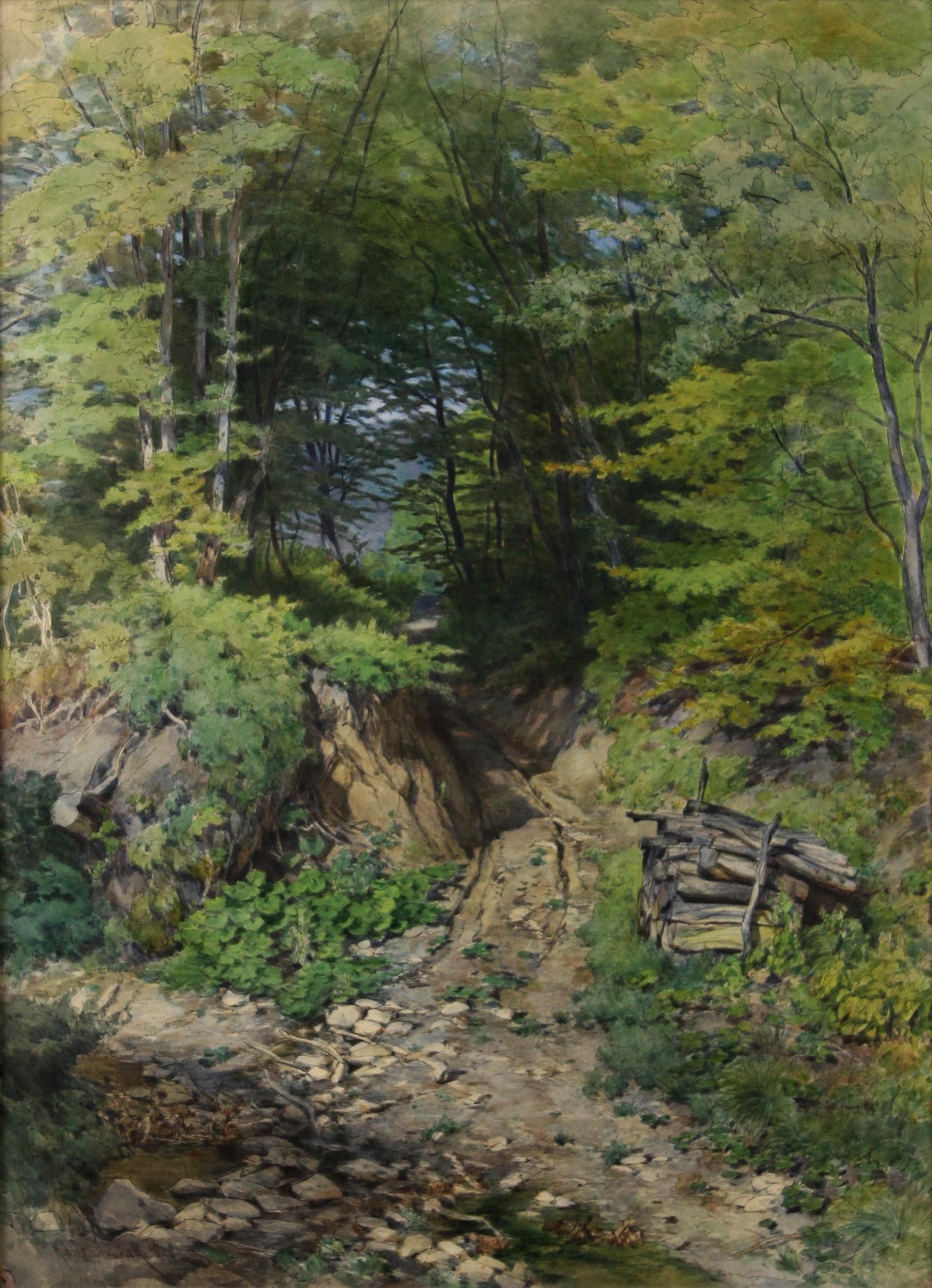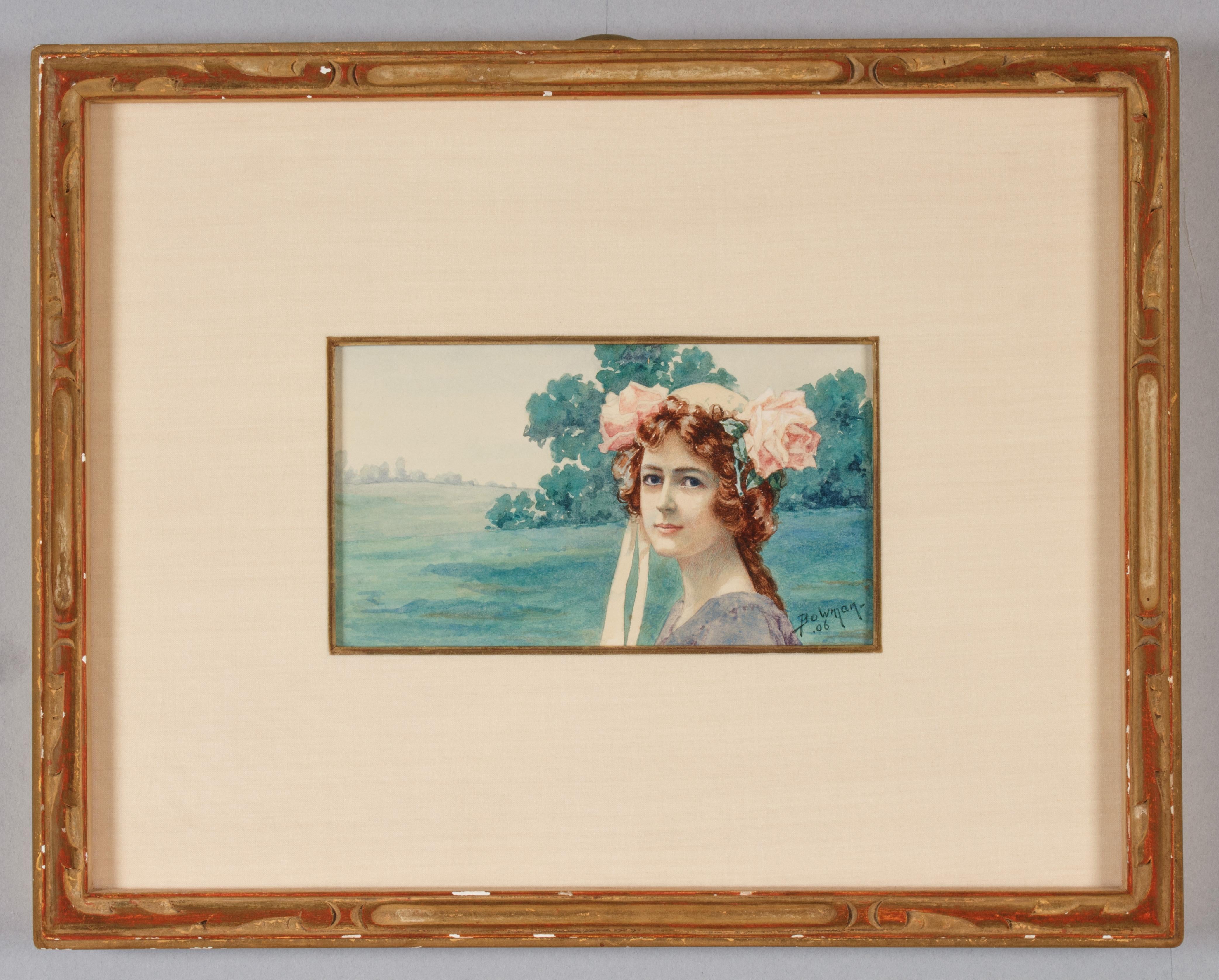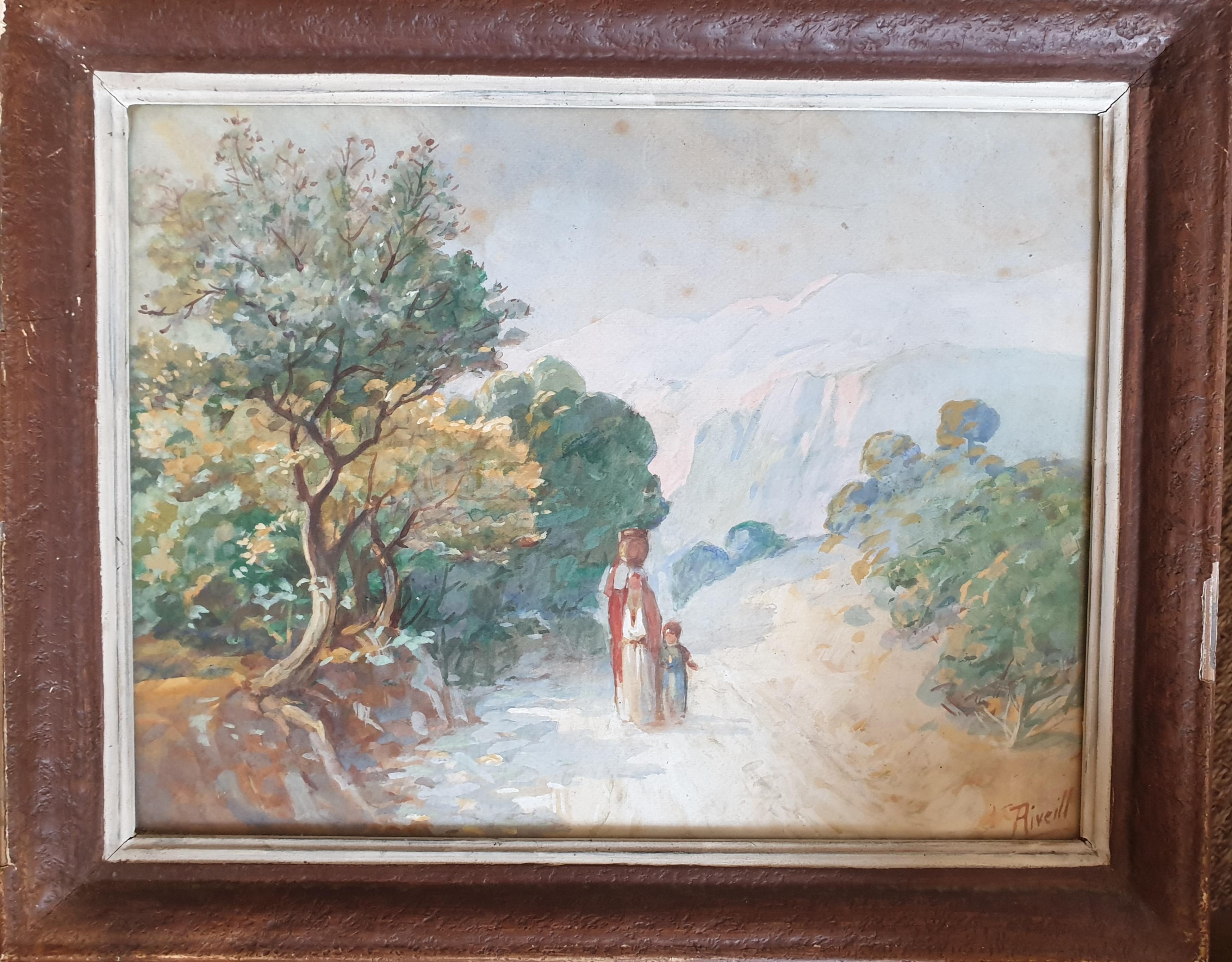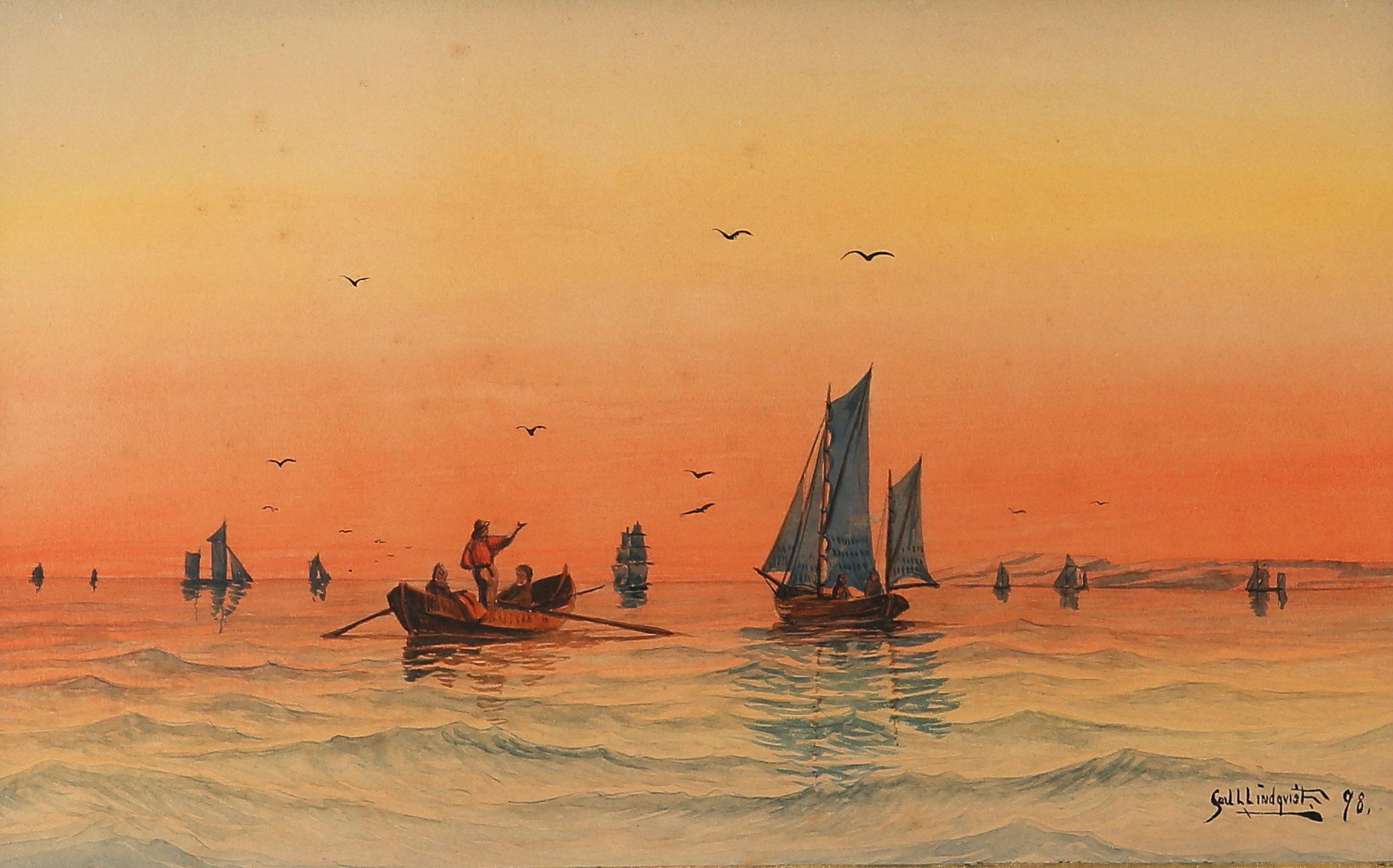Items Similar to High Moorland Landscape in the fog - The world as a transcendent phenomenon -
Want more images or videos?
Request additional images or videos from the seller
1 of 8
High Moorland Landscape in the fog - The world as a transcendent phenomenon -
About the Item
Charles Edward Brittan Jr (1870 Plymouth - 1949). High moor landscape in the fog. Gouache, signed at lower left "Charles E. Brittan", 18 x 34.5 cm (passepartout), 45 x 62 cm (frame). Framed under glass.
- The world as a transcendent phenomenon -
About the artwork
We view the landscape as if from a wide angle. The sparse vegetation of Scottish highland heather - the field of vision, so to speak - expands into the picture in a wedge shape, only to immediately exceed the limits of the picture to the side. This widening of the field of vision makes the objects in the very near foreground seem distant, even though they are almost tangible against the visibly diffuse landscape. The withdrawal of perspective gives the landscape a visionary character, which is reinforced by the bluish mist that spreads into the foreground and by the sheep, which visibly lose their visual reference points as they move further away. This visionary quality culminates in the appearance of the elongated, gently curving silhouettes of the mountains and the light phenomena that appear above them, which seem as close to the present as the diffuse yellowish-brown foreground.
Here Charles Edward Brittan congenially implements the Romantic pictorial idea developed by Caspar David Friedrich in his metaphysical landscape paintings, which took landscape painting to a whole new level. The gaze directed into the picture is blurred, so that from the realm beyond visual perception, something is able to form on the edge of perception, opening up a perception of the supersensible sphere.
About the artist
Trained by his father of the same name, Charles Edward Brittan painted mainly landscapes and animals, but also worked as an illustrator. He worked mainly in Devon, where he produced his most cherished views of Dartmoor, capturing its varied and characteristic atmosphere.
Selected Bibliography
Huon L. Mallalieu: The dictionary of British watercolour artists up to 1920, Woodbridge 1976.
Melissa Hardie (Hg.): Artists in Newlyn and West Cornwall. 1880 - 1940, Bristol 2009.
GERMAN VERSION
Charles Edward Brittan jun. (1870 Plymouth - 1949). Hochmoorlandschaft im Nebel. Gouache, signiert unten links "Charles E. Brittan", 18 x 34,5 cm (Passepartout Innenmaß), 45 x 62 cm (Rahmen). Unter Glas gerahmt.
- Die Welt als transzendente Erscheinung -
zum Werk
Der Betrachter blickt wie in einer Weitwinkelperspektive auf die Landschaft. Dabei weitet sich der spärliche Bewuchs des schottischen Hochlandheidekrauts - gleichsam stellvertretend für das Sehfeld - keilförmig in das Bild hinein, um die Bildgrenzen sogleich seitlich zu übersteigen. Durch diese Weitung des Blicks wirken bereits die Gegenstände des allernächsten Vordergrundes entfernt, obwohl sie vor der zusehends diffundierenden Landschaft beinahe greifbar scheinen. Der perspektivisch erwirkte Entzug verleiht der Landschaft einen visionären Charakter, der durch die bläulichen, sich bis in den Vordergrund hinein verbreitenden Nebelschwaden ebenso verstärkt wird wie durch die Schafe, die sich mit zunehmender Entfernung zusehends als visuelle Anhaltspunkte verlieren. Dieser visionäre Zug kulminiert schließlich in der Erscheinung der langgezogenen, weich geschwungenen Bergsilhouetten und den sich darüber offenbarenden Lichtphänomenen, die ebenso nahe gegenwärtig wirken wie der diffundierende gelb-brauntonige Vordergrund.
Auf kongeniale Weise setzt Charles Edward Brittan hier Bildidee der Romantik um, die Caspar David Friedrich in seinen, die Landschaftsmalerei auf ein ganz neues Niveau hebenden metaphysischen Landschaftsbildern entwickelt hat. Der in das Bild hineingerichtete Blick verschwimmt, damit sich aus dem der visuellen Wahrnehmung jenseitigen Bereich heraus etwas an der Grenze der Wahrnehmung zu formieren vermag, das eine Ahndung der übersinnlichen Sphäre eröffnet.
zum Künstler
Charles Edward Brittan wurde von seinem gleichnamigen Vater ausgebildet und malte vor allem Landschaftsbilder und Tierdarstellungen, war darüber hinaus aber auch als Illustrator tätig. Vorwiegend in Devon ansässig, schuf er dort seine besonders geschätzten Ansichten des Dartmoores, dessen vielfältige charakteristische Atmosphäre er bildlich einzufangen verstand.
Auswahlbibliographie
Huon L. Mallalieu: The dictionary of British watercolour artists up to 1920, Woodbridge 1976.
Melissa Hardie (Hg.): Artists in Newlyn and West Cornwall. 1880 - 1940, Bristol 2009.
- Attributed to:Charles Edward Brittan (1870 - 1949, British)
- Dimensions:Height: 17.72 in (45 cm)Width: 24.41 in (62 cm)Depth: 1.58 in (4 cm)
- Medium:
- Movement & Style:
- Period:
- Condition:
- Gallery Location:Berlin, DE
- Reference Number:1stDibs: LU2438212379362

About the Seller
5.0
Vetted Seller
These experienced sellers undergo a comprehensive evaluation by our team of in-house experts.
Established in 2014
1stDibs seller since 2023
7 sales on 1stDibs
Typical response time: 7 hours
- ShippingRetrieving quote...Ships From: Berlin, Germany
- Return PolicyA return for this item may be initiated within 14 days of delivery.
More From This SellerView All
- Shady hollow way - Into the heart of the forest -By Hans DvoràkLocated in Berlin, DEHans Dvořák (19th century). Shady hollow way in a sunny forest. Watercolour and pen-and-ink drawing, 58.5 x 43 cm (visible size), 70 x 55.5 cm (frame), signed and dated "Hans Dvořák ...Category
1880s Realist Landscape Drawings and Watercolors
MaterialsWatercolor
- Red blooming war landscape with dead soldier - Bleeding flowers -Located in Berlin, DEJohannes Friedrich Heinrich Hänsch (1875-1945), Red blooming war landscape with dead soldier, 1918. Watercolor and gouache on paper, 15 x 24.5 cm (image), 27 x 37 cm (sheet size / frame), monogrammed and dated "19JH18" at lower left. - Paper slightly darkened About the artwork Despite the relatively small format, the watercolor with an internal frame depicts a panoramic view of a flat landscape stretching to the horizon. As far as the eye can see, the poppies bloom in flaming red. The flowers are not rendered individually, however, creating an almost cohesive red surface. The bright red is interspersed with vegetal green. A complementary contrast that creates an intense color effect. In this color contrast, a white area breaks through from the middle ground, widening towards the foreground and surrounding a brown hole. Next to it, in blue, is the actual protagonist of the painting, the first thing that catches the eye: a dead soldier. Next to him is his helmet, revealing the empty interior. The brown, hollow shape corresponds to the hole in the ground. A shell funnel is surrounded by bright ash, which, like the inverted helmet, becomes a sign of death. The soldier's arms point to the funnel, while the empty helmet paraphrases the calotte of the skull and, like the funnel, thematizes the empty darkness of death. The soldier's body, however, is intact and not - as in Otto Dix's triptych "The War" - a dismembered corpse. Instead, Johannes Hänsch activates the landscape, especially the color, to illustrate a blooming landscape of death that extends from the shell funnel in the foreground to the rising column of smoke on the horizon. If the soldier's body is intact, the tangle of barbed wire emblematically placed over the empty helmet also appears tattered. On the right side of the picture, the barbed wire even seems to stretch its arms to the sky in horror. Against the background of this allegory, the content of the bright red also becomes clear: the landscape is drenched in blood, literally a sea of blood, and the single unknown soldier stands pars pro toto for all those who died on the battlefield. Dying in war is not dying in community, but in solitude. In order to emphasize the isolation in death, Johannes Hänsch has set the blue of the soldier in the axis given by his body in the middle ground of the picture into the red sea. A master of landscape painting, Hänsch succeeds in creating a natural-looking landscape allegory that illustrates the horror and death of war, without depicting the brutality of war itself. This singular 'war memorial' of the unknown soldier is the opposite of heroization and yet the dignity of the deceased soldier is preserved through the integrity of his body. About the artist As the son of the sculptor Adolf Haensch, the young Johannes received his first artistic training in his father's Berlin studio. However, he eventually decided to become a painter, and in 1897 he entered the Berlin Academy of Arts. He initially studied under Paul Vorgang and Eugen Bracht, and was particularly influenced by Bracht's increasingly colourful landscape painting. In 1901 he moved to the class of Friedrich Kallmorgen, with whom he spent several weeks on excursions into nature. In 1905 he became a master pupil of Albert Hertel, who taught him watercolour painting. From 1903 to 1933 he exhibited annually at the Great Berlin Art Exhibition, the exhibitions of the Berlin Artists' Association and the Munich Glaspalast. In 1905 he was awarded the Carl Blechen...Category
1910s Realist Figurative Drawings and Watercolors
MaterialsWatercolor
- Wettersteinkamm - The blue of the mountains -Located in Berlin, DEAdalbert Holzer (1881 Munich - 1966 Munich). Wettersteinkamm. Watercolour, 29 x 34.5 cm (visible size), 37.5 x 43 cm (frame), signed and dated at lower right 'ADALBERT HOLZER [19]23'. Framed behind glass. Frame shows signs of wear. - The blue of the mountains - About the artwork The Wetterstein ridge is revealed to the viewer from a gentle, snow-covered hill. In contrast to conventional depictions of mountains, the painting is composed entirely of shades of blue, which condense into the blue-grey of the rock or fade into the white of the snow. As a complementary colour to the blue, Holzer virtuously activates the ochre ground. The uniform yet exciting polarity of the colours emphasises the massive majesty of the mountains and at the same time underlines the special character of the Wetterstein ridge. Holzer transferred the translucency of glass painting, in which he was originally trained, to watercolour and developed a pictorial language related to the art of Ferdinand Hodler, which earned him the nickname 'Master of Blue' and led to the appreciation of his watercolours in particular. About the artist After an apprenticeship as a stained glass painter at the Kunstgewerbeschule, Adalbert Holzer studied at the Munich Art Academy under Carl von Marr...Category
1920s Realist Landscape Drawings and Watercolors
MaterialsWatercolor
- Wind Dodgers at the Baltic SeaLocated in Berlin, DETheodor Scheerbaum (1897 Reichenbach im Vogtland), Wind Dodgers at the Baltic Sea. Watercolor on strong yellowish grained paper, 44 x 56 cm, signed by hand "Th[eodor] Scheerbaum" at ...Category
1950s Realist Landscape Drawings and Watercolors
MaterialsWatercolor
- Evening Cottage Scene / - Somewhere in Nowhere -Located in Berlin, DEArthur Claude Strachan (1865 Edinburgh - 1954 Minehead), Evening Cottage Scene. Watercolor on paper, mounted, 28 x 46 cm (visible size), 48 x 65 cm (fra...Category
Early 1900s Realist Landscape Drawings and Watercolors
MaterialsPaper
- The Ruins of St. Clement's Church in Visby, Sweden / - Real romanticism -Located in Berlin, DEOtto Günther-Naumburg (1856-1941), The Ruins of St. Clement's Church in Visby, Sweden. Watercolor and ink, heightened with white, on sand-colored paper, mounted on cardboard, 33 x 24...Category
Early 20th Century Realist Landscape Drawings and Watercolors
MaterialsPaper
You May Also Like
- Watercolor Portrait of a Girl with Roses signed Bowman 1906Located in Philadelphia, PAUnknown Artist (Bowman) (early twentieth century) Girl with Roses Watercolor on paper, 5 x 8 inches Framed: 13 x 16 inches Signed and dated at lower right: “Bowman/.06”Category
Early 1900s Realist Landscape Drawings and Watercolors
MaterialsPaper, Watercolor
- The Chestnut Vendor: an early 20th century Italian watercolor signed A.MattoliniLocated in Philadelphia, PAA. Mattolini (Italian, early twentieth century) The Chestnut Vendor Watercolor on paper, 12 3/4 X 9 inches Signed at lower left: “A Mattolini”Category
Early 20th Century Realist Figurative Drawings and Watercolors
MaterialsWatercolor, Paper
- The Watercarrier, Orientalist Watercolour.Located in Cotignac, FREarly 20th century orientalist watercolour on paper by Aiveill, signed bottom right. In art history, Orientalism is the imitation or depiction ...Category
Early 20th Century Realist Landscape Drawings and Watercolors
MaterialsPaper, Watercolor, Gouache
- Notre-Dame de Paris. Paper, watercolor, 26.5x18 cmBy Edward NevilLocated in Riga, LVEdward Nevil ( 1813 – 1901 ) Notre-Dame de Paris. Paper, watercolor, 26.5x18 cmCategory
Mid-19th Century Realist Landscape Drawings and Watercolors
MaterialsPaper, Watercolor
- Sunset Sailors is a Watercolor by Swedish Artist Carl L Lindqvist, Painted 1898Located in Stockholm, SEDiscover this watercolor "Sunset Sailors" by Carl L. Lindqvist (1856-1941). Step into the enchanting world of the Swedish artist Carl L. Lindqvist with his captivating watercolor pa...Category
1890s Realist Landscape Drawings and Watercolors
MaterialsWatercolor
- Quiet Contemplation: Rural Serenity in Hagborg's WatercolorBy August HagborgLocated in Stockholm, SEThe artwork we present is a rare watercolor by the distinguished Swedish artist August Hagborg, painted in the later part of his career between 1910 and 1920. This watercolour is a departure from Hagborg's often-seen beach scenes with mussel pickers and instead offers a glimpse into a serene, pastoral moment. The scene is set against a timber house, with a man and a woman standing alongside, their gazes directed away from the viewer, which invites contemplation about the story behind their distant stares. Watercolors by Hagborg are rare, making this piece particularly special. Its fine details suggest a mastery of the medium, likely honed over the years of his extensive career. A written letter from Göteborgs Konstmuseum, dated to the 1940s, suggests a later date for this piece. August Hagborg, born on May 26, 1852, in Gothenburg and passed away on April 30, 1921, in Paris, was a renowned figure in the art world. His education at the Royal Swedish Academy of Arts in Stockholm from 1871 to 1874 placed him among peers who would rise to prominence, such as Carl Larsson and Anders Zorn. Moving to Paris in the fall of 1875, Hagborg initially painted within the costume genre before finding his niche in coastal landscapes that garnered him accolades and recognition. Hagborg's success was punctuated by his 1879 painting...Category
1910s Realist Landscape Drawings and Watercolors
MaterialsWatercolor




